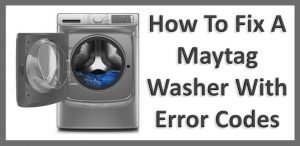
Error codes like F2 are your washing machine’s way of letting you know something isn’t quite right. Imagine it’s like when your car’s check engine light comes on. You know it’s not ideal, but it doesn’t mean your car’s about to explode. The F2 error specifically indicates a problem with the washing machine’s drain system. It means your washer isn’t draining properly, which can lead to a whole host of issues if left unchecked. So, what happens if you just ignore it? Let’s dive in and find out.
Understanding the F2 Error Code
The F2 error code is essentially your Maytag washing machine saying, “Hey, I’ve got a problem with draining water.” Think of it like a clogged sink. The water wants to escape, but something’s blocking its path. In your washer, this could be due to a clogged drain hose, a faulty pump, or even an issue with the control board. If you’ve noticed your laundry room floor looking more like a paddling pool lately, this error is a likely culprit.
You might be wondering why this is such a big deal. Well, if your washer can’t drain water effectively, it means your clothes might not get rinsed thoroughly. This can lead to detergent residue on your clothes, which isn’t just annoying — it can also cause skin irritation for those with sensitive skin. Plus, standing water in your washer can be a breeding ground for mold and mildew, which brings a whole new set of problems.
Ignoring this error code might seem tempting because, really, who wants to deal with appliance trouble? But here’s the deal: just like ignoring a leaky roof, ignoring this issue can lead to more significant damage over time. If the water doesn’t drain, it could start affecting other internal components of your washer, leading to more expensive repairs down the line.
Consequences of Not Fixing the Error
Let’s say you decide to cross your fingers and hope the error goes away on its own. Unfortunately, that’s unlikely to happen. The F2 error is persistent. If water isn’t draining, it might end up back in your drum, soaking your clothes after the spin cycle. Imagine opening your washer to find your clothes wetter than when you put them in — not a pleasant surprise.
Over time, the stagnant water can cause rust and corrosion on metal parts. This might not seem like a big deal initially, but corrosion can weaken these parts, eventually causing them to fail. A failed component means you’ll have to replace parts or possibly the whole machine. And trust me, buying a new washing machine is much more expensive than fixing a little drain issue.
Moreover, there’s the risk of water damage. If the water isn’t drained properly, it could start leaking from the machine, damaging your laundry floor. Think of it like a slow, steady leak that, over time, can warp floors, ruin carpets, and even affect the structural integrity of your home. Not to mention the growth of mold and mildew, which could affect the air quality in your home.
Steps You Can Take
So, what can you do about it? First things first: don’t panic. If you’re somewhat handy, checking a few things might solve the problem. Start by ensuring that the drain hose isn’t kinked or clogged. It’s like checking your garden hose for a blockage when the water flow is weak.
Next, examine the filter and pump. These are common trouble spots. Often, small items like coins or lint can cause a blockage. If you feel comfortable, gently remove any debris and see if that solves the problem. However, if you’re not confident in taking the machine apart, calling a professional might be the best option. Sometimes, it’s better to let someone who knows the ins and outs of washers handle the repairs.
Remember, regular maintenance can go a long way. Running a cycle with vinegar or a washing machine cleaner can help prevent build-up in the first place. It’s like using a hair mask regularly to avoid split ends rather than waiting until you need a haircut.
Preventative Measures and Final Thoughts
Imagine if you could prevent errors like F2 from even happening. Well, with a little care and attention, you can minimize the risk. Always make sure your washer is level and not overloaded. It’s like packing a suitcase; overstuff it, and something’s bound to go wrong. Regularly check and clean the machine’s lint filter to ensure it’s free of debris.
Consider running a cleaning cycle every month. This helps keep everything in tip-top shape and can dissolve any detergent build-up. Using the right amount of detergent is crucial too. Too much can lead to excess suds, which can cause drainage issues and trigger error codes.
In conclusion, while an F2 error might seem like a minor inconvenience, ignoring it can lead to bigger problems. By taking prompt action and performing regular maintenance, you’ll keep your Maytag washer running smoothly and avoid the hassle of costly repairs. So next time you see that F2 code pop up, you’ll know exactly what to do.